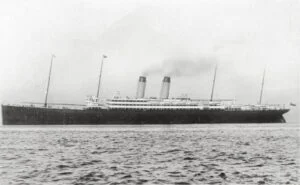
Passenger lists are an important source of information about immigrants arriving in the United States (or Canada and South America). For researching Germans from Russia, these records provide a link between information known from US sources to the pre-immigration origin. This page provides guidance for locating passenger arrival information for Germans from Russia immigrants. Germans from Russia immigrant information published by AHSGR can be access using the following link.
Access AHSGR Published Passenger Lists

Beginning in 1820, the United States government began keeping better track of immigrant passenger arrivals. Passenger arrival lists, also known as customs passenger lists or customs manifests, were provided to the customs officer at the port of arrival before passengers could disembark. Information found on these passenger arrival lists was limited and may include port of departure, port of arrival, date of arrival, name of ship, origin location (country, province, or village), name of immigrant (and family members’ names if they traveled together), age and sex of immigrant, and occupation.
The office of the Superintendent of Immigration was established in the United States in 1891, and the customs passenger lists changed to immigration passenger lists. These immigration records typically included more information than the earlier customs passenger records. Information on these lists may include, but are not limited to, the following:
- Port of departure
- Port of arrival
- Date of arrival
- Name of ship
- Nationality of immigrant
- Name of immigrant (and family members’ names if they traveled on the same ship)
- Age and sex of immigrant
- Occupation
- Whether the immigrant had been to the United States before
- Final destination of the immigrant
- If the passenger was joining a relative, the name of the relative and where the person lived
- Who paid for the passage
- The amount of money the immigrant had in his or her possession
After 1906, passenger lists began to include a physical description of the immigrant, place of birth (typically country, many also have the city or village), and name and address (typically village) of the nearest living relative back home.
Access to Passenger Lists
The United States National Archives and Records Administration has Passenger Arrival Records for arrivals to the United States from foreign ports between approximately 1820 and December 1982. Records older than 75 years are publicly available, and many have been digitized by National Archives partners Ancestry and FamilySearch. FamilySearch can be accessed for free by creating an account. Your local library may provide free access to Ancestry.
Tips for Searching Digital Passenger List Records
- The journey to the Americas involved several legs and modes of transportation. The final leg of the journey typically departed from a European port outside of Russia.
- Begin your search using information that you are most confident in, e.g., surname, year of birth, year of arrival, country of origin. If your search does not yield matches, remove some information to broaden the search.
- Passenger lists were handwritten so information is often misspelled or may be illegible. Names are often spelled phonetically. Search using alternative spellings or search without specifying a surname.
- Even if you are confident in the year of birth or year of arrival, broaden the search to find dates within a range of a few years.
- If you know the German Russian village origin location, include this in the search. On Ancestry it works best to place the village name in the “keyword” field. Use all the alternate spellings you are aware of. Since village names changed over time, use the village name in place at the time of immigration. If you can’t find the surname of interest, try searching without the surname and use the village name.
- Some records are not available on both FamilySearch and Ancestry, so both websites should be searched. Not all passenger lists held by the National Archives have been digitized by Ancestry or FamilySearch.
- If you do not find what you are looking for at Ancestry or FamilySearch, for New York arrivals a Passenger Search should also be done at The Statue of Liberty-Ellis Island Foundation, Inc.
- While Ellis Island in New York is the most famous port of arrival, European immigrants arrived at many other US ports in the late 19th and early 20th century, for example: Philadelphia, Pennsylvania; Baltimore, Maryland; Boston, Massachusetts; Portland, Maine; Providence, Rhode Island; Galveston, Texas; and New Orleans, Louisiana.
- Germans from Russia immigrants may have entered the US before settling in Canada, or visa versa.
- When you locate the passenger record of interest, you should skim through the entire list of passengers on that voyage. It was common for relatives or neighbors from a village to travel together.
- When you locate the passenger ship name of interest, you can perform a web search on the ship name to find information about the ship, including photos of the ship.
The Odessa3 organization also has a list of arriving passengers which can be viewed at: Odessa3 Passenger Ship List.
The Library and Archives of Canada provides an on-line searchable database of arrivals from 1865-1922.
Passenger lists are typically available for arrivals in other countries. Many records are available through Ancestry or FamilySearch.
AHSGR Published Passenger Lists
Before the availability of web-based access to digital passenger records, access to records held by the National Archives was limited. During this time, AHSGR published passenger arrival information about Germans from Russia. This information was published in the AHSGR Journal, Clues and Work Papers. Information was also published in the Heritage Review by the Germans from Russia Heritage Society (GRHS). Note that these published records are not complete. They do not capture all Germans from Russia arrivals and they may not contain all data fields available in the original passenger record.
A searchable index of the AHSGR publications is available using the following links. This index is searchable by ship name, surname or village name.